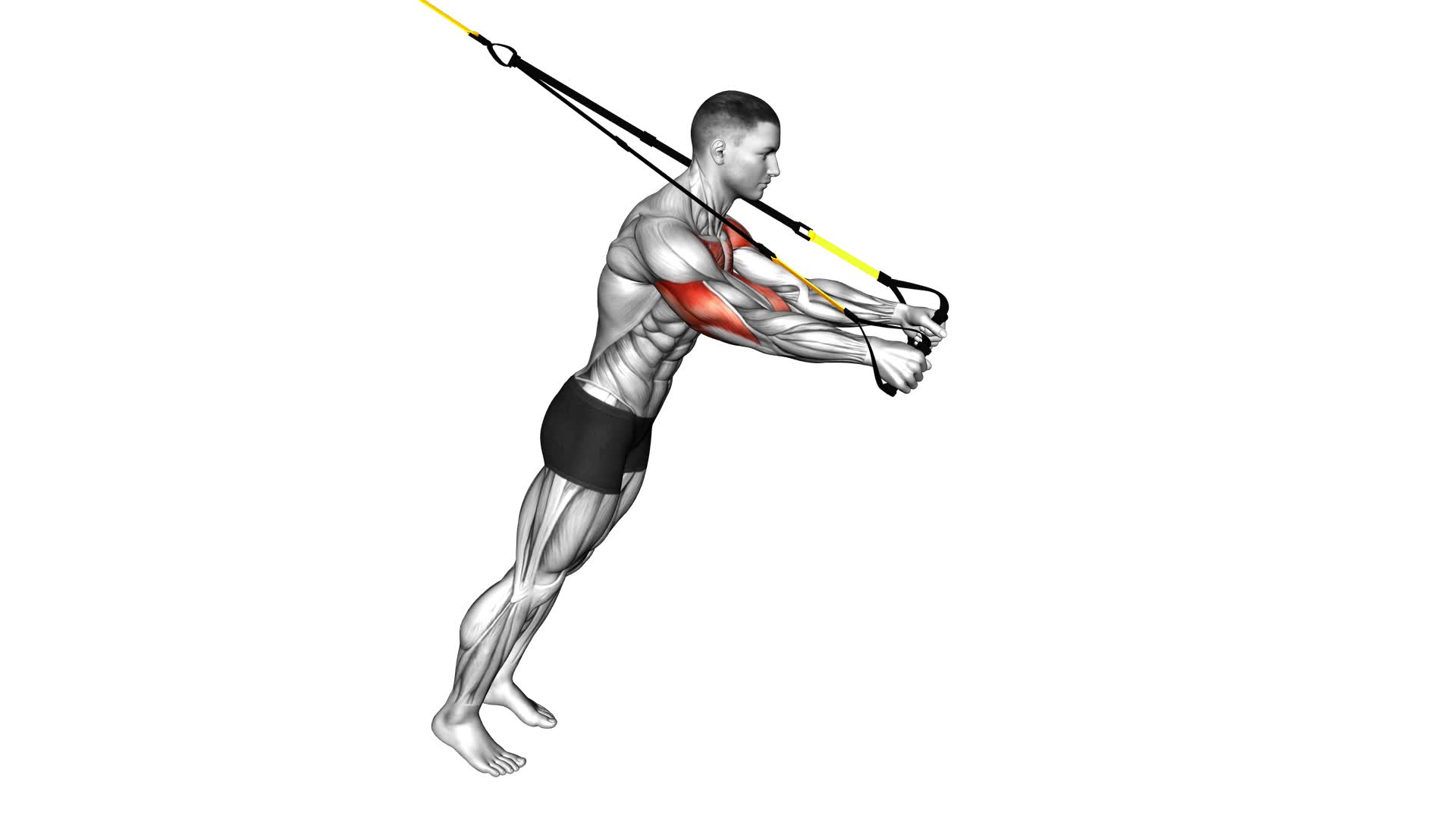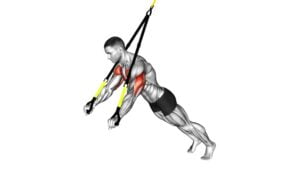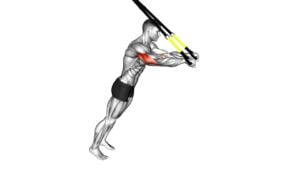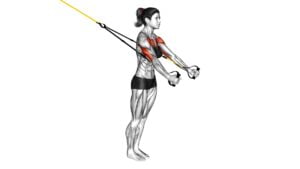Suspension Close Grip Chest Press (Male) – Video Exercise Guide & Tips

Get ready to sculpt your chest with the Suspension Close Grip Chest Press! This exercise targets your pecs, triceps, and shoulders, giving you a powerful upper body.
Watch This Exercise Video
In this video exercise guide, you'll learn the proper form and technique to maximize your gains. Plus, we'll share variations and progressions to keep challenging yourself.
Avoid common mistakes and get tips to make this exercise even more effective.
Let's get started and take your chest training to the next level!
Key Takeaways
- Suspension Close Grip Chest Press is highly effective in activating the chest muscles and leads to improved muscle strength and development.
- It engages muscles more effectively than traditional chest exercises and provides a versatile alternative.
- Incorporating Suspension Close Grip Chest Press targets the chest and triceps muscles, works all major muscle groups, and improves chest strength and upper body stability.
- Proper form during Suspension Close Grip Chest Press includes adjusting the straps, maintaining a close grip with palms facing each other, and controlling the movement throughout the exercise.
Benefits of Suspension Close Grip Chest Press
The suspension close grip chest press offers a multitude of benefits for individuals looking to target their chest muscles. This exercise is highly effective in activating the chest muscles, specifically the pectoralis major and pectoralis minor. By using the suspension trainer, you can engage these muscles more effectively than traditional chest exercises, as the instability of the straps requires greater activation of the chest muscles to stabilize and control the movement. This leads to improved muscle strength and development in the chest area.
An advantage of the suspension close grip chest press is that it provides a versatile alternative to traditional chest exercises. This exercise allows for a greater range of motion and can be adjusted to target different areas of the chest, such as the upper or lower chest. Additionally, the use of the suspension trainer allows for a greater emphasis on core stability and engagement, as the body must work harder to maintain proper alignment and balance during the exercise.
Incorporating the suspension close grip chest press into your workout routine can help you achieve a stronger and more defined chest. It's important, however, to remember that proper form and technique are crucial to avoid injury and maximize the benefits of this exercise.
Proper Form and Technique for Suspension Close Grip Chest Press
To perform the suspension close grip chest press with proper form and technique, you should:
- Position yourself on the suspension trainer and adjust the straps to a challenging but controlled length.
- Grasp the handles with a close grip, palms facing each other.
- Keep your body straight and engage your core muscles.
- Lower your body by bending your elbows until your chest is just above the handles.
- Keep your elbows close to your sides throughout the movement.
- Push through your palms and extend your arms to bring your body back to the starting position.
It's important to maintain control and avoid swinging or using momentum to complete the exercise. By keeping the movement slow and controlled, you'll maximize muscle activation in your chest, triceps, and shoulders.
Now, let's discuss some common errors to avoid during the suspension close grip chest press:
- Allowing your elbows to flare out to the sides reduces the effectiveness of the exercise and puts unnecessary strain on your shoulders. Remember to keep your elbows close to your sides throughout the movement.
- Rushing through the exercise and using momentum to push yourself up takes away from the muscle activation and can lead to improper form. Focus on maintaining a slow and controlled movement, feeling the tension in your chest and triceps as you press up.
Variations and Progressions of Suspension Close Grip Chest Press
Now, let's explore different variations and progressions you can incorporate into your suspension close grip chest press routine. By incorporating advanced variations, you can challenge your muscles in new ways and target different muscle groups. Here are two sub-lists of variations and progressions you can try:
Advanced Variations:
- Single-arm Suspension Close Grip Chest Press: Perform the exercise with one arm at a time, using the suspension trainer. This variation increases the demand on your core and stabilizer muscles, while also targeting your chest.
- Decline Suspension Close Grip Chest Press: Set the suspension trainer at a lower anchor point, so that your feet are elevated higher than your hands. This variation increases the difficulty of the exercise, engaging your upper chest muscles to a greater extent.
Muscle Groups Targeted:
- Chest: The suspension close grip chest press primarily targets your chest muscles, specifically the pectoralis major and pectoralis minor.
- Triceps: This exercise also engages your triceps muscles, located at the back of your upper arms. The close grip position places more emphasis on the triceps, helping to strengthen and tone them.
Incorporating these advanced variations and focusing on the targeted muscle groups will help you continue to challenge yourself and make progress in your suspension close grip chest press routine.
Common Mistakes to Avoid During Suspension Close Grip Chest Press
Avoid these common mistakes when performing the suspension close grip chest press to maximize your results and prevent injury. One of the most common mistakes is using too much momentum instead of relying on your chest muscles to do the work. Remember to maintain control throughout the entire exercise to ensure you're engaging your chest muscles effectively.
Another mistake to avoid is placing your hands too close together on the handles. This can strain your wrists and put unnecessary pressure on your shoulders. Instead, position your hands slightly wider than shoulder-width apart to maintain proper form and reduce the risk of injury.
Additionally, make sure to keep your core engaged and your back straight throughout the exercise. Avoid arching your back or letting it sag, as this can lead to lower back pain and compromise the effectiveness of the exercise.
Lastly, don't forget to breathe. It's common to hold your breath while performing challenging exercises, but this can increase your blood pressure and put additional stress on your body. Remember to inhale as you lower your body and exhale as you push back up.
If you find the suspension close grip chest press too challenging or if you want to switch things up, there are alternative exercises you can try. Dumbbell chest presses, push-ups, or machine chest presses are all effective alternatives that target the same muscle groups while providing different variations and intensity levels.
Tips to Maximize the Effectiveness of Suspension Close Grip Chest Press
Maximize the effectiveness of your suspension close grip chest press by focusing on proper form and engaging your chest muscles fully. Here are some tips to help you get the most out of this exercise:
- Modify the suspension close grip chest press for beginners:
- Start with a higher anchor point for the suspension straps to reduce the difficulty level.
- Use lighter resistance or bodyweight only until you have built enough strength and stability.
Incorporate the suspension close grip chest press into a full body workout routine:
- Pair it with exercises that target different muscle groups, such as squats or lunges, to create a well-rounded workout.
- Alternate between upper and lower body exercises to allow for adequate rest and recovery.
By modifying the exercise for beginners, you can gradually build strength and progress to more challenging variations. Incorporating the suspension close grip chest press into a full body workout routine ensures that you're working all major muscle groups and maximizing your time at the gym. Remember to always maintain proper form and listen to your body to avoid any injuries.
With consistency and dedication, you'll soon see improvements in your chest strength and overall fitness level.
Frequently Asked Questions
How Many Sets and Reps Should I Perform for the Suspension Close Grip Chest Press?
To determine the optimal weight for the suspension close grip chest press, you should consider your fitness level and goals. It's recommended to start with a weight that challenges you but allows you to maintain proper form.
As for the sets and reps, a good starting point is 3-4 sets of 8-12 reps. Remember to rest between sets and gradually increase the weight as you get stronger.
There are also variations of this exercise that you can explore to target different muscles.
Can Suspension Close Grip Chest Press Help With Building Overall Upper Body Strength?
Incorporating suspension training into your workout routine can provide numerous benefits, including building overall upper body strength.
The suspension close grip chest press is a great exercise to target your chest, triceps, and shoulders.
To progress and increase the difficulty of this exercise, you can adjust the angle of your body by moving your feet closer to the anchor point.
This will engage your muscles even more and challenge your strength.
Is Suspension Close Grip Chest Press Suitable for Beginners?
Suspension close grip chest press is a great exercise for beginners. It helps build overall upper body strength and has numerous benefits.
To perform it properly, make sure to maintain a good form. Keep your body straight, engage your core, and grip the handles firmly.
Lower yourself down by bending your elbows, and then push back up to the starting position.
Incorporating this exercise into your routine will yield excellent results.
Can Suspension Close Grip Chest Press Be Performed Using Different Types of Suspension Trainers?
Yes, suspension close grip chest press can be performed using different types of suspension trainers.
The benefit of using different types of suspension trainers for close grip chest press is that it allows you to vary the resistance and target different muscles in your chest.
This exercise is great for chest development as it targets the pectoral muscles and helps to build strength and definition.
Incorporating suspension trainers into your workouts can help add variety and challenge to your routine.
Are There Any Modifications or Alternatives to the Suspension Close Grip Chest Press for Individuals With Shoulder Injuries?
If you have shoulder injuries, there are alternatives and modified versions of the chest press exercise that you can try. These modifications can help reduce strain on your shoulders while still targeting your chest muscles.
Some alternatives to consider include using dumbbells or resistance bands instead of suspension trainers. Additionally, you can try incline or decline chest presses as they can put less stress on your shoulders.
Remember to always consult with a healthcare professional before trying any new exercises.
Conclusion
In conclusion, the suspension close grip chest press is a highly effective exercise for targeting and strengthening the chest muscles. By using a suspension trainer, you can engage your core and stabilizer muscles while performing this exercise.
It's important to maintain proper form and technique to maximize the effectiveness of the exercise and avoid common mistakes. By following these tips and progressing with variations, you can achieve optimal results and enhance your upper body strength.

Author
Years ago, the spark of my life’s passion ignited in my mind the moment I stepped into the local gym for the first time. The inaugural bead of perspiration, the initial endeavor, the very first surge of endorphins, and a sense of pride that washed over me post-workout marked the beginning of my deep-seated interest in strength sports, fitness, and sports nutrition. This very curiosity blossomed rapidly into a profound fascination, propelling me to earn a Master’s degree in Physical Education from the Academy of Physical Education in Krakow, followed by a Sports Manager diploma from the Jagiellonian University. My journey of growth led me to gain more specialized qualifications, such as being a certified personal trainer with a focus on sports dietetics, a lifeguard, and an instructor for wellness and corrective gymnastics. Theoretical knowledge paired seamlessly with practical experience, reinforcing my belief that the transformation of individuals under my guidance was also a reflection of my personal growth. This belief holds true even today. Each day, I strive to push the boundaries and explore new realms. These realms gently elevate me to greater heights. The unique combination of passion for my field and the continuous quest for growth fuels my drive to break new ground.



